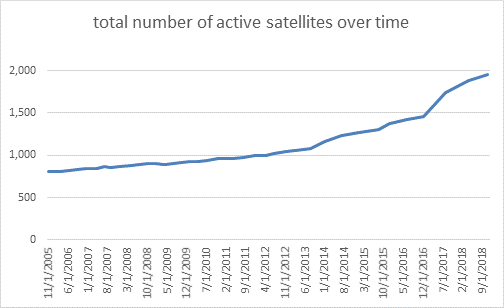An updated version of the UCS Satellite Database has been posted. Including launches and deactivations through November 30, 2018, the Database includes information on about 1,957 active satellites. That is 71 more than our previous release last July.

We are trying to set a regular rhythm of thrice-yearly updates, which is slightly less frequent than in that past. One reason it’s going more slowly is the sheer number of satellites launched, as launching and operating smaller and cheaper satellites has become increasingly viable.
Five years ago, each new update included twenty or thirty new satellites. Currently we are adding between 100-200 new satellites each update (with 26 pieces of information for each). The net number of active satellites doesn’t increase this quickly because we are also removing satellites as they deorbit or become inactive.
Since we are just almost across the 2,000 satellite line, I was curious to go back and see how the total satellite numbers have grown over time. I plotted the total number of active satellites for each of the 38 database updates we’ve produced since 2005.

We’ve been producing the database for about 13 years. About halfway through, we hit the 1,000 satellite mark; in other words it took around 6 ½ years to get from 800 to 1,000 satellites. There were plenty of launches, but also plenty of deactivations. (You can see the lists of satellites added and deleted over this whole period in our Changes to the Database document. We just add on the new information at the top of the list.) It only took the next 6 1/2 years to go from 1,000 to nearly 2,000.
The growth in number doesn’t map directly to growth in on-orbit capacity. Much of this growth is driven by launches of large numbers of smaller, less capable satellites. Currently, there are at least 470 satellites on orbit with a reported launch mass of 10 kg or less. In the January 1, 2012 database, we listed 21 such satellites. (NB: We don’t have reported masses for 7.5% of the satellites in the database.) About 500 satellites with masses greater than 2,500 kg are currently active on-orbit. So roughly a quarter of satellites have launch masses of 10 kg or less, and about a quarter have masses of 2,500 kg or greater.
Of course, numbers of satellites don’t tell the complete story about capability. The most massive satellites, schoolbus-sized classified military imaging satellites, are enormously capable, much more so than toaster-sized smallsats. As we move into the small satellite era, a better metric for on-orbit capability of a country, for example, will probably be total on-orbit mass or on-orbit power. We will keep trying to get more complete data on these parameters.
